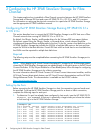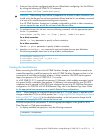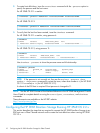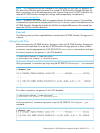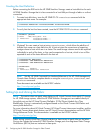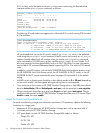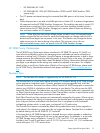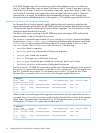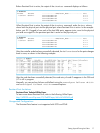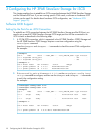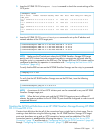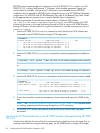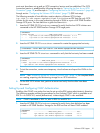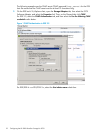
◦ HP 3PAR HBA 4G: 1638
◦ HP 3PAR HBA 8G: 3276 (HP 3PAR StoreServ 10000 and HP 3PAR StoreServ 7000
systems only)
• The I/O queues are shared among the connected host HBA ports on a first-come, first-served
basis.
• When all queues are in use and a host HBA port tries to initiate I/O, it receives a target queue
full response from the HP 3PAR StoreServ Storage port. This condition can result in erratic I/O
performance on each host. If this condition occurs, each host should be throttled so that it
cannot overrun the HP 3PAR StoreServ Storage port's queues when all hosts are delivering
their maximum number of I/O requests.
NOTE: When host ports can access multiple targets on fabric zones, the assigned target
number assigned by the host driver for each discovered target can change when the host is
booted and some targets are not present in the zone. This situation may change the device
node access point for devices during a host reboot. This issue can occur with any
fabric-connected storage, and is not specific to the HP 3PAR StoreServ Storage.
HP 3PAR Priority Optimization
The HP 3PAR Priority Optimization feature introduced in HP 3PAR OS versions 3.1.2.MU2 is a
more efficient and dynamic solution for managing server workloads and can be utilized as an
alternative to setting host I/O throttles. Using this feature, a storage administrator is able to share
storage resources more effectively by enforcing quality of service limits on the array. No special
settings are needed on the host side to obtain the benefit of Priority Optimization although certain
per target or per adapter throttle settings may need to be adjusted in rare cases. For complete
details of how to use Priority Optimization (Quality of Service) on HP 3PAR arrays, please read
the HP 3PAR Priority Optimization technical white paper available at http://www.hp.com/go/
bsc.
Persistent Ports
NOTE: The Persistent Ports feature is supported only on HP 3PAR OS 3.1.2.
The Persistent Ports (or virtual ports) feature minimizes I/O disruption during an HP 3PAR Storage
online upgrade or node-down event. Currently, persistent ports are supported only with Fibre
Channel connections. Persistent Ports allows a Fibre Channel HP 3PAR Storage port to assume the
identity (port WWN) of a failed port while retaining its own identity. The solution uses the NPIV
feature for Fibre Channel. This feature does not work in direct-connect mode and is supported only
on Fibre Channel target ports that connect to Fibre Channel fabric and are in point-to-point mode
where both the active and partner ports share the same fabric.
Each Fibre Channel port has a partner port automatically assigned by the system. Where a given
physical port assumes the identity of its partner port, the assumed port is designated as a persistent
port. Array port failover and failback with Persistent Ports is transparent to most host-based
multipathing software which, in most cases, can keep all its I/O paths active.
The Persistent Ports feature is activated by default during node-down events (online upgrade or
node reboot). Port shutdown or reset events do not trigger this feature. Persistent Ports is enabled
by default starting with the HP 3PAR OS 3.1.2 software.
In the event that an HP 3PAR Storage node is downed during an online upgrade or node-down
event, the Fibre Channel target ports fail over to their partner ports. For example, in a two-node
HP 3PAR Storage array configuration, if ports 0:1:1, 0:5:1 and 1:1:1, 1:5:1 are connected to
the fabric, then if node 0 goes down, ports 0:1:1, 0:5:1 fail over to ports 1:1:1, 1:5:1 and become
active while ports 1:1:1, 1:5:1 remain active.
Setting Up and Zoning the Fabric 15




